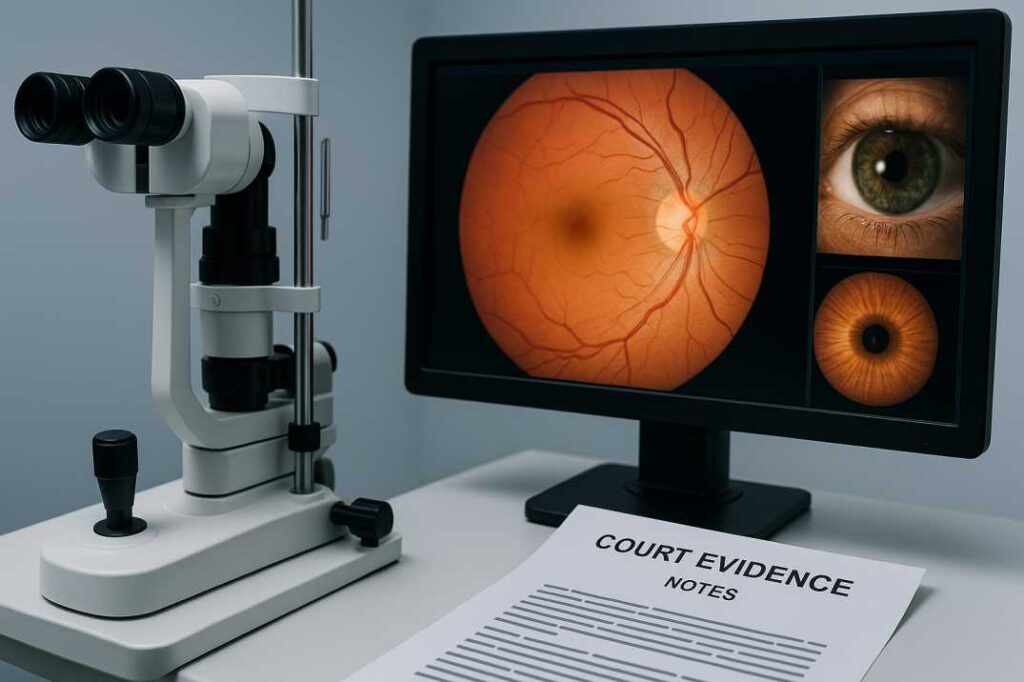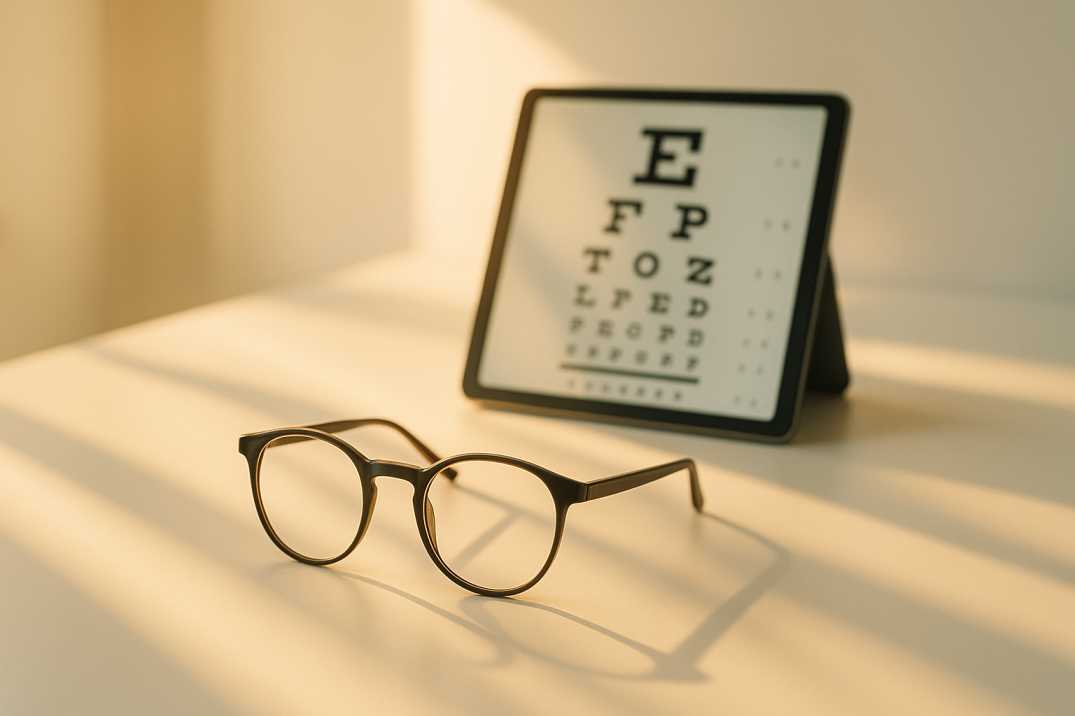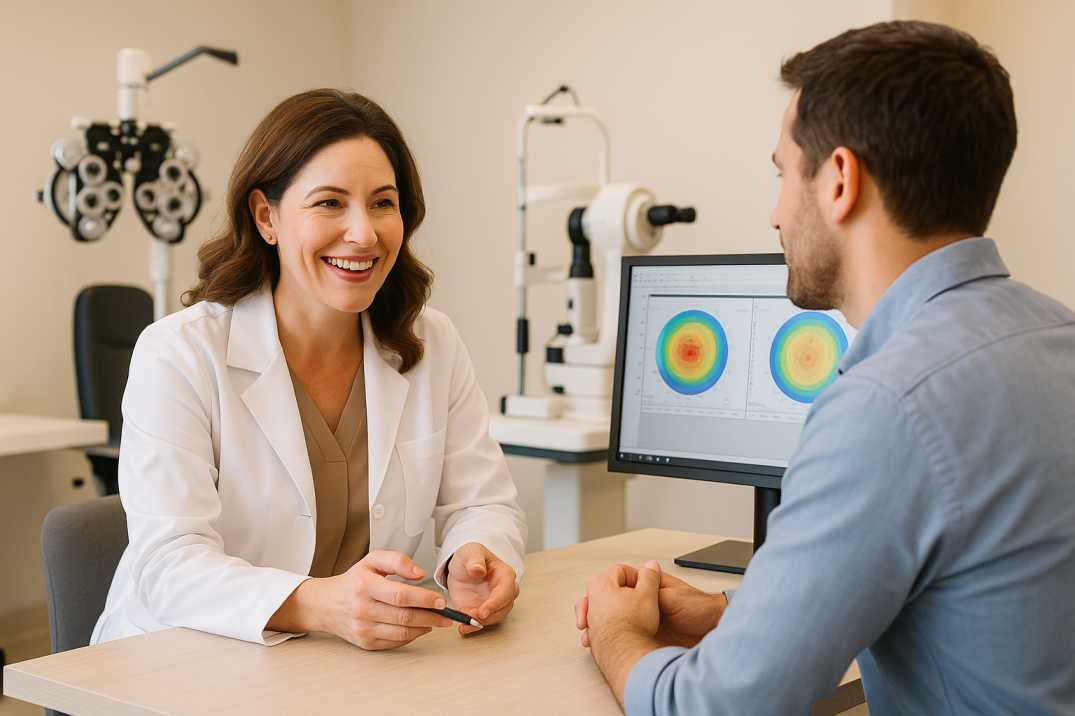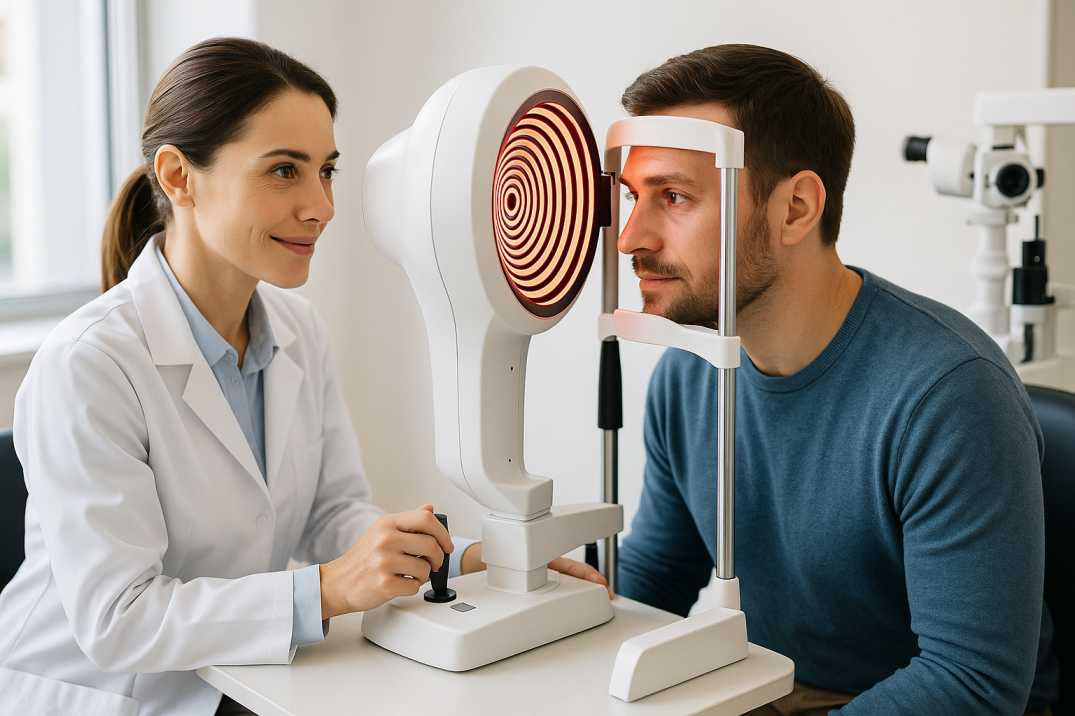Forensic Eye Exams: What Courts Need to Know in 2025
When vision becomes a critical piece of evidence in legal proceedings, forensic eye exams provide the scientific foundation for determining what someone could or couldn’t see during an incident. These specialized assessments bridge optometric science and the justice system, offering objective, court-admissible testimony that can make the difference between conviction and acquittal, or between successful and dismissed claims.
Whether you’re a legal professional seeking expert vision testimony, an individual involved in a personal injury case, or someone curious about this specialized field, understanding forensic eye exams is essential. This comprehensive guide explores how professional vision assessments work within the legal system, when they’re needed, and what makes them different from standard eye examinations.
What Are Forensic Eye Exams?
Forensic eye exams are specialized vision assessments conducted to provide objective, scientific evidence for legal proceedings. Unlike routine eye examinations that focus on diagnosing vision problems and prescribing corrective lenses, forensic exams specifically evaluate what a person could see during an incident relevant to a legal case, whether that’s a traffic accident, criminal event, workplace injury, or medical malpractice situation.
These examinations apply optometric science to answer critical legal questions, such as: Could a defendant identify a person or object at a specific distance? Did poor vision contribute to an accident? Was vision impairment caused by trauma or negligence? The results provide courts with evidence-based insights that help establish facts in criminal, civil, and malpractice cases.
The Science Behind Forensic Optometry
Forensic optometry applies rigorous scientific methods to analyze eye health, visual capabilities, and ocular injuries in legal contexts. Recent research has shown that eye-related evidence remains underutilized in forensic science despite its significant potential to solve crimes and support legal claims. A comprehensive 2024 study published in the International Journal of Ophthalmology examined 54 research articles and found that forensic optometry plays a crucial role in criminal investigations, domestic violence cases, and sexual assault prosecutions.
The examination process relies on established optometric testing protocols adapted for legal purposes. Rather than simply measuring current vision, forensic optometrists reconstruct visual capabilities at a specific point in time, often working backward from medical records, witness statements, and physical evidence to determine what someone could have seen during an incident.
When Are Forensic Eye Exams Needed?
Forensic eye exams become necessary whenever vision-related questions arise in legal proceedings. These specialized assessments serve multiple legal areas, each with unique evidentiary requirements and applications.
Criminal Cases
In criminal proceedings, forensic eye exams help establish whether a defendant or witness had the visual capability to identify people, read license plates, recognize faces, or perceive events as described in their testimony. These assessments evaluate visual acuity at specific distances, peripheral vision limitations, color perception, and night vision capabilities.
For example, if a witness claims to have identified a suspect from 100 feet away in low-light conditions, a forensic eye exam can objectively determine whether that witness’s vision would have made such identification possible. This scientific evidence helps courts assess the reliability of eyewitness testimony, which research shows is frequently inaccurate even under ideal conditions.
Personal Injury Claims
Personal injury litigation frequently requires forensic eye exams to document vision impairment caused by accidents, workplace incidents, or exposure to harmful substances. These assessments establish the extent of visual damage, determine causation, and project future vision-related limitations that affect compensation calculations.
The examinations provide objective documentation of injuries such as retinal damage, optic nerve injury, traumatic cataracts, or visual field defects. By comparing pre-incident vision capabilities with post-incident assessments, forensic optometrists can demonstrate the direct impact of the injury on daily functioning, employment capacity, and quality of life.
Medical Malpractice Litigation
When patients experience vision loss or complications following eye surgery or treatment, forensic eye exams evaluate whether care met professional standards. These assessments review medical records, examine current eye health, and determine if negligence, surgical errors, or inadequate follow-up caused or contributed to vision problems.
Forensic optometrists analyze whether procedures were performed correctly, whether patients received appropriate pre-operative evaluation, and whether complications were recognized and addressed promptly. This independent expert analysis helps courts understand complex medical issues and determine liability in cases involving LASIK complications, cataract surgery errors, glaucoma mismanagement, or delayed diagnosis of retinal conditions.
Post-Mortem Investigations
Forensic eye exams extend beyond living subjects to provide crucial evidence in death investigations. Medical examiners routinely examine eyes during autopsies to establish the time of death, identify the cause of death, and detect signs of violence or substance abuse.
The eyes offer remarkably precise postmortem indicators. Corneal clouding begins approximately two hours after death and progresses predictably, allowing pathologists to estimate the postmortem interval. Additionally, potassium levels in the vitreous humor increase at a measurable rate after death, providing another scientific method for time-of-death estimation. Petechial hemorrhages in the conjunctivae and eyelids may indicate strangulation or asphyxiation, while specific patterns of eye trauma can reveal violence or abuse.
Components of a Forensic Eye Examination
A comprehensive forensic eye exam follows a systematic protocol designed to document visual capabilities and eye health with the thoroughness required for legal proceedings. Each component serves a specific evidential purpose and contributes to the complete picture of visual function.
Visual Acuity Assessment
Visual acuity testing measures the clarity of vision at various distances using standardized charts. Forensic exams test both near and far visual acuity with and without corrective lenses, documenting precisely what level of detail the person can perceive. This information proves essential when determining whether someone could have read signs, identified faces, or noticed critical details during an incident.
The testing goes beyond standard Snellen chart measurements to include contrast sensitivity, which evaluates the ability to distinguish objects from their background in varying light conditions. This proves particularly relevant for cases involving nighttime incidents or reduced visibility situations.
Visual Field Testing
Peripheral vision assessment determines the full extent of what a person can see without moving their eyes. Visual field testing identifies blind spots, peripheral vision limitations, and any restrictions that might have prevented someone from seeing approaching vehicles, people entering their peripheral view, or events occurring outside their central vision.
These assessments use confrontation field testing or automated perimetry to map the complete visual field, documenting any defects caused by neurological conditions, glaucoma, retinal disease, or trauma. The results help reconstruct exactly what a person could have perceived during an incident from their specific vantage point.
Ocular Health Evaluation
A thorough examination of eye structures identifies injuries, diseases, or abnormalities relevant to the legal questions at hand. Using specialized equipment, including slit lamps, ophthalmoscopes, and advanced imaging technology, forensic optometrists examine:
- External eye structures for signs of trauma or disease
- Corneal clarity and integrity
- Lens transparency and positioning
- Retinal health and integrity
- Optic nerve appearance and function
- Intraocular pressure measurements
- Blood vessel patterns and abnormalities
Advanced imaging techniques such as optical coherence tomography (OCT) and retinal photography create detailed documentation that can be presented as evidence in court, providing visual confirmation of findings that judges and juries can understand.
Color Vision and Depth Perception
Specialized testing evaluates color perception using Ishihara plates or similar standardized tests, important for cases where color identification played a role in the incident. Depth perception assessment determines binocular vision function, relevant for accidents involving distance judgment, such as vehicle collisions or workplace incidents.
Pupillary Response Assessment
Pupil reaction testing evaluates neurological function and can reveal brain injuries, substance impairment, or other conditions affecting vision. The examination documents pupil size, symmetry, and reaction to light, providing evidence relevant to intoxication cases, traumatic brain injury claims, or neurological damage assertions.
The Role of Expert Witness Testimony
Forensic optometrists serve as expert witnesses who translate complex scientific findings into clear, understandable testimony for judges and juries. Their role extends far beyond conducting examinations to include comprehensive analysis of medical records, preparation of detailed reports, and courtroom testimony that withstands rigorous cross-examination.
Qualifications and Credentials
Effective forensic optometry requires extensive clinical experience combined with specialized legal knowledge. Expert witnesses must hold current optometry licenses, maintain active clinical practices to stay current with standards of care, and understand legal procedures and evidence requirements.
Many forensic optometrists pursue additional training through organizations such as the American College of Forensic Examiners International, learning crime scene investigation techniques, evidence handling protocols, and courtroom testimony skills. This specialized training enables them to bridge the gap between optometric science and legal proceedings effectively.
Medical Record Review
Before conducting independent examinations, forensic optometrists thoroughly analyze existing medical records, previous eye exams, prescription histories, and treatment documentation. This comprehensive review establishes baseline vision capabilities, identifies pre-existing conditions, and traces the progression of any vision changes over time.
The analysis may reveal patterns suggesting negligence, document inadequate follow-up care, or demonstrate that vision problems existed before the incident in question. This historical perspective proves essential for establishing causation and determining liability.
Report Preparation and Documentation
Following examination and record review, forensic optometrists prepare detailed written reports that present findings in clear, professional language accessible to legal professionals without medical training. These reports typically include:
- Complete examination methodology and procedures used
- Objective findings from all testing components
- Analysis of medical records and historical data
- Professional opinions on visual capabilities during the relevant time period
- Causation determinations on a ‘more probable than not’ basis
- Supporting scientific literature and standards of care
- Visual aids such as diagrams, photographs, or imaging results
These reports form the foundation for depositions and trial testimony, providing documented evidence that attorneys can reference during proceedings.
Courtroom Testimony and Depositions
Expert witness testimony requires the ability to explain technical concepts clearly while maintaining scientific accuracy. Forensic optometrists must withstand cross-examination, defend their methodologies, and present findings in ways that help fact-finders understand complex vision science.
Effective expert witnesses remain impartial regardless of which side retained them, basing all opinions on scientific evidence rather than advocacy for either party. This objectivity builds credibility with courts and ensures testimony meets admissibility standards under rules such as Daubert or Frye, depending on jurisdiction.
Recent Scientific Developments in Forensic Optometry
Forensic optometry continues to evolve with advances in imaging technology, diagnostic capabilities, and understanding of vision science. Recent research has expanded the field’s applications and improved the accuracy of forensic assessments.
Study 1: Comprehensive Review of Forensic Optometry Applications (2024)
A landmark 2024 study published in the International Journal of Ophthalmology conducted a comprehensive review of forensic optometry’s role in solving crimes and supporting legal proceedings. The research team analyzed 54 studies examining eye-related evidence in criminal investigations, domestic violence cases, and sexual assault prosecutions.
The study found that 27 of the reviewed articles demonstrated significant value from eye-related forensic evidence, yet noted that ocular signs remain underutilized by forensic scientists despite their potential impact. The researchers emphasized that eye-related clues can provide crucial information about the cause of death, time of death, and the sequence of events leading to criminal incidents.
Key findings included documentation of how tears and eyewear can provide DNA evidence, how corneal clouding patterns estimate time of death, and how specific eye injuries indicate particular types of trauma or violence.
Study 2: Tears and Eyewear in Forensic Investigation (2019)
Research published in Forensic Science International examined the forensic potential of tears and eyewear as sources of biological and physical evidence. The study demonstrated that tears deposited on surfaces such as tissues, bedding, or clothing can be successfully analyzed for DNA profiling, providing a previously underappreciated source of identification evidence.
Additionally, the research highlighted how eyewear analysis can link suspects to crime scenes through prescription matching, frame identification, and lens fragment examination. The landmark Janet Abaroa murder case demonstrated this principle when contact lens evidence from an exhumed body provided critical evidence leading to a conviction, marking the first published documentation of such evidence use in a homicide investigation.
Study 3: Emerging Imaging Technologies in Forensic Medicine (2024)
A systematic review examining emerging forensic imaging technologies highlighted how advanced imaging modalities are revolutionizing forensic examinations, including those involving the eyes. The research documented the increasing use of artificial intelligence in analyzing forensic images, improving accuracy in detecting subtle injuries or abnormalities that human examiners might miss.
The study found that multi-detector computed tomography (MDCT), virtual autopsy techniques, and AI-assisted image analysis significantly improve the precision of post-mortem examinations. These technologies allow non-invasive examination of internal eye structures, preservation of evidence that traditional autopsy might destroy, and creation of detailed three-dimensional reconstructions useful for courtroom presentation.
Differences Between Forensic and Routine Eye Exams
Understanding the distinction between forensic eye exams and standard optometric examinations helps clarify when specialized forensic assessment becomes necessary and what unique elements these examinations provide.
Purpose and Focus
Routine eye exams focus on detecting vision problems, diagnosing eye diseases, and prescribing corrective lenses to improve a patient’s current vision. The goal is treatment and vision optimization.
Forensic eye exams, conversely, focus on documenting visual capabilities as they existed during a specific time period relevant to legal proceedings. The examination aims to answer specific legal questions rather than provide treatment, reconstruct what someone could or couldn’t see during an incident, and provide objective evidence for court proceedings.
Documentation and Reporting
Standard eye exams produce clinical records documenting findings and recommendations for patient care. The documentation remains confidential medical information shared only with the patient and relevant healthcare providers.
Forensic examinations generate detailed legal reports designed for court submission, including comprehensive documentation of methodology, extensive photographic or imaging evidence, and expert opinions stated with appropriate levels of certainty. These reports become part of legal proceedings and may be subject to disclosure and cross-examination.
Examination Scope and Depth
While routine exams follow standard protocols, forensic exams may include specialized testing rarely needed in clinical settings, such as precise visual field mapping at specific distances, detailed contrast sensitivity evaluation under varied lighting conditions, comprehensive analysis of historical vision changes, and specialized imaging to document specific injuries or conditions.
How to Arrange a Forensic Eye Exam
Securing appropriate forensic eye examination services requires understanding the process, finding qualified experts, and ensuring proper coordination between legal and medical professionals.
Finding Qualified Forensic Optometrists
Not all optometrists provide forensic services, making it essential to identify practitioners with specific forensic training and experience. Legal professionals should seek experts who maintain active clinical practices, have testified in court proceedings previously, understand legal evidence requirements, and belong to professional organizations focused on forensic sciences.
Organizations such as the American College of Forensic Examiners International maintain directories of qualified forensic optometry experts. State optometric associations can also provide referrals to practitioners with forensic experience.
Initial Consultation Process
Forensic eye exams typically begin with a consultation between the attorney and the forensic optometrist to discuss case specifics, determine what questions need answering, and establish whether a forensic examination will provide valuable evidence. During this consultation, attorneys should provide relevant case documents, medical records, witness statements describing visual events, and specific questions the examination should address.
The forensic expert reviews these materials to determine if the examination can address the legal questions and whether they have the necessary expertise and equipment. Not all cases benefit from forensic eye exams, and responsible experts decline matters outside their scope of expertise or where examination is unlikely to provide useful evidence.
Scheduling and Coordination
Forensic examinations must be scheduled directly between the legal team and the forensic optometrist, typically outside the expert’s regular clinical hours. The examination requires more time than routine eye exams, often 60-90 minutes or longer, depending on complexity.
Patients should bring any current eyeglasses or contact lenses, previous eye exam records if available, a list of current medications, and documentation related to the legal case. The examiner explains all procedures, obtains informed consent, and ensures the patient understands the examination’s legal purpose.
Cost Considerations
Forensic eye examinations typically cost significantly more than routine eye exams due to the specialized expertise required, extensive documentation and report preparation, potential testimony requirements, and the time-intensive nature of forensic work. Fees vary widely depending on case complexity, geographic location, and the expert’s experience level.
Legal professionals should discuss fees upfront, understanding that charges typically include examination time, record review, report preparation, and may include separate fees for deposition and trial testimony. Many forensic experts require retainers before beginning work.
Ethical Considerations and Impartiality
Forensic optometry operates at the intersection of science and law, requiring strict adherence to ethical standards that maintain the integrity of expert testimony and ensure fair legal proceedings.
Conflict of Interest Management
Responsible forensic optometrists carefully screen cases for potential conflicts of interest before accepting engagements. They decline matters where they have treated parties involved in the case previously, have personal relationships with individuals involved, or have financial interests in the case outcome beyond their expert fees.
Maintaining independence from both parties ensures that expert opinions remain objective and court-admissible. This impartiality proves essential for credibility, as courts recognize that biased expert testimony undermines the justice system.
Scientific Objectivity
Expert witnesses serve the court first, not the attorneys who retain them. This means forensic optometrists must report findings honestly, even when those findings don’t support the retaining party’s position. Their role is to present scientific evidence and expert opinions based on that evidence, not to advocate for a particular outcome.
This commitment to objectivity sometimes means telling attorneys their case lacks merit from a vision standpoint or that evidence doesn’t support claimed visual limitations. While this honesty may seem counterproductive, it actually serves justice by preventing frivolous claims and ensuring courts receive reliable scientific information.
Working with Both Sides
Many forensic optometrists work with both plaintiffs and defendants, both prosecution and defense, maintaining their commitment to scientific truth regardless of which side retains them. This balanced approach demonstrates that their opinions derive from evidence rather than payment source.
Common Misconceptions About Forensic Eye Exams
Several myths and misunderstandings surround forensic optometry. Clarifying these misconceptions helps legal professionals and potential clients understand what forensic eye exams can and cannot accomplish.
Myth: Current Vision Proves Past Visual Capabilities
Many people assume that a current eye exam definitively establishes what someone could see in the past. However, vision changes over time due to disease progression, injury healing, or normal aging processes. Forensic optometrists must carefully analyze historical records, trace vision changes, and make informed reconstructions of past visual capabilities based on available evidence.
Myth: Forensic Exams Always Support the Retaining Party
Ethical forensic optometrists maintain objectivity regardless of who pays their fees. Their opinions must derive from scientific evidence, not advocacy for either side. This means examinations sometimes produce findings that don’t support the retaining party’s position. Responsible experts communicate these findings honestly rather than tailoring opinions to suit desired outcomes.
Myth: Any Optometrist Can Perform Forensic Exams
While all optometrists possess clinical skills for examining eyes, forensic work requires additional training in legal procedures, evidence standards, report writing, and courtroom testimony. Effective forensic experts understand how to present scientific information in legal contexts and withstand rigorous cross-examination. Simply being a skilled clinician doesn’t automatically qualify someone for forensic work.
The Future of Forensic Eye Examinations
Forensic optometry continues evolving with technological advances and growing recognition of its value in legal proceedings. Several trends are shaping the field’s future development.
Advanced Imaging Technologies
Optical coherence tomography (OCT), advanced retinal photography, and three-dimensional imaging provide increasingly detailed documentation of eye structures and conditions. These technologies allow the detection of subtle injuries or diseases that earlier methods might miss, creating more compelling visual evidence for courtroom presentation.
Artificial intelligence applications are beginning to assist in analyzing forensic images, potentially improving consistency and accuracy in detecting specific findings. However, AI tools supplement rather than replace expert judgment, as understanding context and drawing appropriate conclusions still require human expertise.
Increased Recognition in Legal Proceedings
As more attorneys and judges become familiar with forensic optometry’s capabilities, demand for these specialized services continues to grow. Courts increasingly recognize the value of expert vision testimony in cases where visual evidence proves critical to establishing facts.
This growing awareness may lead to more standardized practices, professional guidelines, and quality standards for forensic eye examinations. Professional organizations are developing certification programs and practice standards to ensure forensic optometrists maintain high levels of competence.
Expanded Applications
Beyond current uses, forensic optometry may expand into additional legal areas such as employment discrimination cases involving vision requirements, disability claims requiring vision documentation, aviation or transportation incident investigations, and workplace safety evaluations regarding visual demands.
Additional Resources and Research Citations
The following resources provided essential research, data, and insights for this comprehensive guide on forensic eye exams. These authoritative sources offer additional depth for readers seeking to explore specific aspects of forensic optometry and vision science in legal contexts.
1. International Ophthalmology: Forensic Optometry Review Study (2024)
Citation: Khan, S., Pant, K., & Pandey, H. (2024). A review study on forensic optometry: new insights in forensic science to solve crime scenes, domestic violence, and sexual assaults. International Ophthalmology, 44(1), 235.
Link: https://link.springer.com/article/10.1007/s10792-024-03202-w
Key Findings: This landmark 2024 systematic review examined 54 research studies on forensic optometry applications. The researchers found that while eye-related evidence plays a crucial role in criminal investigations, domestic violence cases, and sexual assault prosecutions, ocular signs remain significantly underutilized by forensic scientists. The study highlights how corneal clouding, vitreous humor analysis, tear DNA profiling, and eyewear examination can provide critical evidence for determining the cause of death, time of death, and establishing chronological sequences of events. This peer-reviewed research demonstrates the growing recognition of forensic optometry’s importance in modern legal proceedings and criminal justice.
2. Forensic Science International: Tears and Eyewear Evidence (2019)
Citation: Aparna, R., & Shanti Iyer, R. (2019). Tears and eyewear in forensic investigation-a review. Forensic Science International, 306, 110055.
Link: https://pubmed.ncbi.nlm.nih.gov/31785512/
Key Findings: This groundbreaking research, published in a leading forensic science journal, explores how tears and eyewear serve as valuable sources of forensic evidence. The study documents DNA profiling techniques for tears found on various surfaces, including bedding, tissues, and clothing, demonstrating successful personal identification from tear samples. Additionally, the research examines eyewear forensics, including spectacle and contact lens analysis for prescription matching and suspect identification. The paper notably references the Janet Abaroa murder case, which marked the first published documentation of contact lens evidence from an exhumed body being used to secure a homicide conviction, demonstrating real-world applications of these forensic techniques.
3. Cannon EyeCare: Expert Witness in Optometry Services (2025)
Source: Cannon EyeCare – Seattle Optometry Practice specializing in Forensic Eye Examinations and Expert Witness Services
Link: https://seattleeyecaredoctor.com/expert-witness-in-optometry/
Practice Overview: Dr. Mark J. Cannon, OD, board-certified optometrist practicing in Seattle, Washington, has provided expert witness services in optometry for criminal and civil cases since 2016. His practice offers comprehensive forensic eye examination services, including medical record review, independent vision assessments, expert documentation for court proceedings, and courtroom testimony. Dr. Cannon’s forensic work spans personal injury cases, criminal proceedings, and medical malpractice litigation. His expertise in forensic optometry, combined with active clinical practice maintaining current standards of care, provides the Seattle legal community with accessible, high-quality forensic vision assessment services. The practice emphasizes impartiality and scientific objectivity, working with both plaintiffs and defendants, prosecution and defense, to provide evidence-based expert opinions.
Conclusion: The Critical Role of Forensic Eye Exams
Forensic eye exams provide essential scientific evidence that helps courts establish facts in criminal prosecutions, civil litigation, and medical malpractice cases. By objectively documenting visual capabilities and eye health, these specialized assessments bridge the gap between optometric science and legal proceedings.
Whether evaluating a defendant’s ability to identify faces in low light, documenting vision loss from a workplace accident, assessing whether medical care met professional standards, or providing post-mortem analysis, forensic optometry applies rigorous scientific methods to answer critical legal questions.
For legal professionals, understanding when to utilize forensic eye exams and how to work effectively with forensic optometrists enhances case preparation and strengthens evidence presentation. For individuals involved in legal matters where vision questions arise, these examinations provide objective documentation of visual capabilities that may prove decisive in case outcomes.
As technology advances and awareness grows, forensic optometry will continue expanding its role in the justice system, ensuring that vision-related evidence receives the scientific analysis it deserves. The field represents a vital intersection of healthcare and law, where medical expertise serves the pursuit of justice through objective, evidence-based analysis.
If you need forensic eye examination services or expert testimony for a legal matter, consult with experienced forensic optometrists who maintain the highest standards of scientific objectivity and professional ethics. Their specialized expertise can provide the visual evidence your case requires.
FAQs
-
A forensic eye exam is a specialized vision assessment that evaluates visual capabilities during legal incidents, measuring visual acuity, field limitations, and ocular health for court proceedings.




